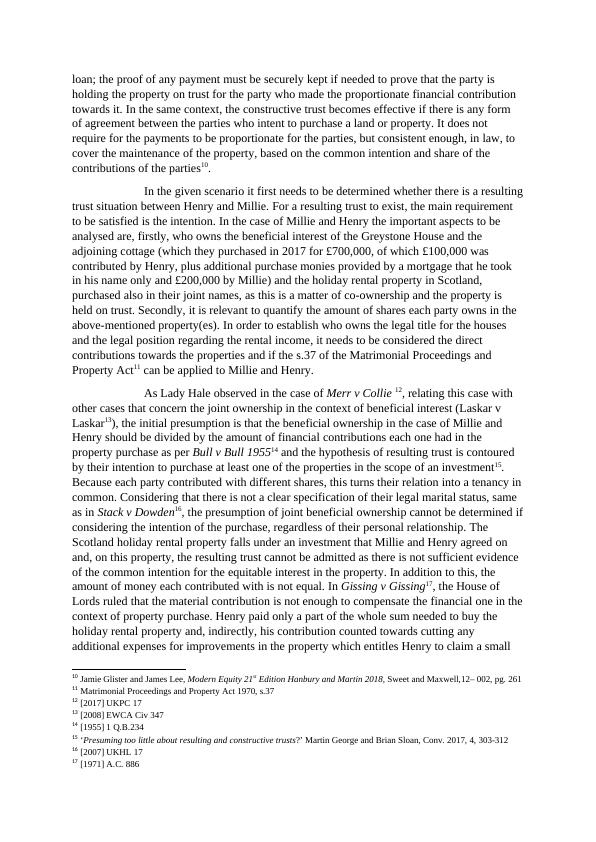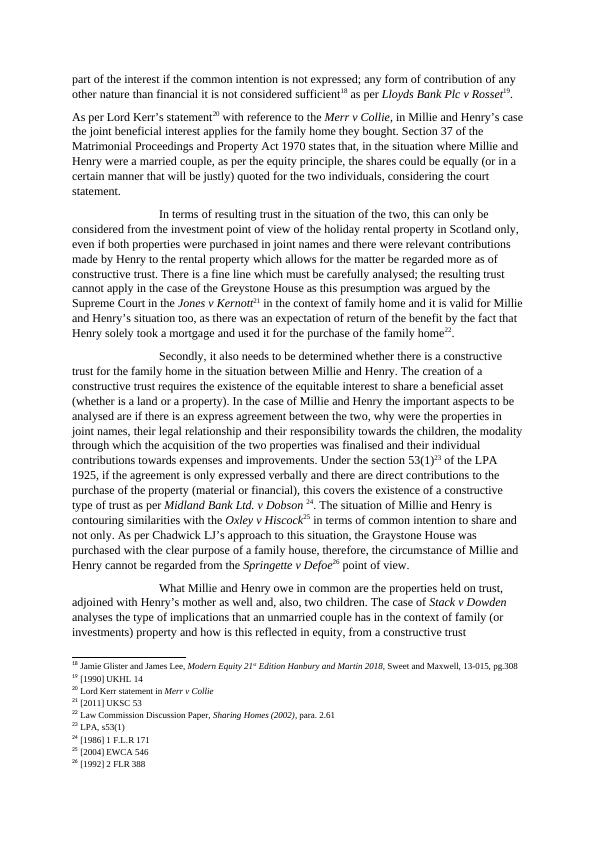Ask a question from expert
Legal Aspects of an Implied Trust: Application to Greystone House, the adjoining cottage and the Scottish rental property
7 Pages3319 Words77 Views
Added on 2021-03-22
About This Document
Module Topic: Problem Question, January 2021 Student Name: Oana-Madalina Hornet Student Number: LON181002004 In the following content, the relevant aspects of an implied trust will be analysed to provide Henry, Millie, and Frances with relevant legal advice in relation to their interests in Greystone House, the adjoining cottage and the Scottish rental property considering as fundamental basis their legal position regarding the income from the Scottish property.
Legal Aspects of an Implied Trust: Application to Greystone House, the adjoining cottage and the Scottish rental property
Added on 2021-03-22
BookmarkShareRelated Documents
Module Topic: Problem Question, January 2021Student Name: Oana-Madalina HornetStudent Number: LON181002004 In the following content, the relevant aspects of an implied trust will be analysed to provide Henry, Millie, and Frances with relevant legal advice in relation to their interests in Greystone House, the adjoining cottage and the Scottish rental property considering as fundamental basis their legal position regarding the income from the Scottish property. Based on further legal resources, the content of the essay will advise Frances whether she can be forced to leave the cottage considering her contributions.In the context of equity, in law, a trust can be legally expressed or imposed. When talking of implied trust, the term itself does not owe a self-statutory definition; it is a ramification of the private trust1 as it was classified in the Law Property Act2 from 1925, at section 53(2). The implied trust is defined by the nature of the circumstances and, in most of the situations it is divided into either - a resulting trust3, if the transferor shows intention for a property conveyance but he/she is the party who makes the most significant payments. The beneficial interest of the property is accountable to him/her as per MacMillan INC v Bishopsgate Investments Trust PLC (No.3)4. When talking about resulting trust, must not consider that the rules applicable to the express trust apply to the resulting trust too. The resulting trusts do not require to comply with any formalities and following this, the children (if they are involved) can also be regarded as a resulting trustee’s in this type of trust, as per Re Vinogradoff5 case from 1936, or constructive trust6. Constructive trust, as observed in Soar v Ashwell7 case from 1893 is a principle which explains that, in equity, if a property is held by a person – different than the owner, that individual is required to hold that particular property on trust for the owner. It adopts the doctrine of precedent and its purpose is to obtainthe favourable outcome in a particular case as per Eves v Eves8, by observing the justiciable and reliable aspects of the cited law cases, as per Hussey v Palmer9, throughout the significant legal history of the middle of the 20th century. There is not much to differentiate between the two concepts of trust in what concerns the applicability of the rule of formalities, as this is not a mandatory requirement to create a resulting or a constructive trust, but these two categories of implied trust cannot be adjoined either. If applied in family property context, the resulting trust arises when one of the parties made a direct payment with the clearly expressed intention to buy a property registered under the other parties’ name. The purpose of the contribution is not as a gift or 1 Jamie Glister and James Lee, Modern Equity 21st Edition Hanbury and Martin 2018, Sweet and Maxwell, 2-028, pg.562 Law Property Act 1925, s53(2)3 Ibid. 11 – 001, pg. 2274 [1995] 1 W.L.R. 9785 [1936] W.N 686 Ibid. 12-001, pg. 2607 [1893] 2 Q.B. 3908 [1975] 1 W.L.R. 13389 [1972] 1 W.L.R. 1286

loan; the proof of any payment must be securely kept if needed to prove that the party is holding the property on trust for the party who made the proportionate financial contribution towards it. In the same context, the constructive trust becomes effective if there is any form of agreement between the parties who intent to purchase a land or property. It does not require for the payments to be proportionate for the parties, but consistent enough, in law, to cover the maintenance of the property, based on the common intention and share of the contributions of the parties10. In the given scenario it first needs to be determined whether there is a resultingtrust situation between Henry and Millie. For a resulting trust to exist, the main requirement to be satisfied is the intention. In the case of Millie and Henry the important aspects to be analysed are, firstly, who owns the beneficial interest of the Greystone House and the adjoining cottage (which they purchased in 2017 for £700,000, of which £100,000 was contributed by Henry, plus additional purchase monies provided by a mortgage that he took in his name only and £200,000 by Millie) and the holiday rental property in Scotland, purchased also in their joint names, as this is a matter of co-ownership and the property is held on trust. Secondly, it is relevant to quantify the amount of shares each party owns in the above-mentioned property(es). In order to establish who owns the legal title for the houses and the legal position regarding the rental income, it needs to be considered the direct contributions towards the properties and if the s.37 of the Matrimonial Proceedings and Property Act11 can be applied to Millie and Henry. As Lady Hale observed in the case of Merr v Collie12, relating this case with other cases that concern the joint ownership in the context of beneficial interest (Laskar v Laskar13), the initial presumption is that the beneficial ownership in the case of Millie and Henry should be divided by the amount of financial contributions each one had in the property purchase as per Bull v Bull 195514and the hypothesis of resulting trust is contoured by their intention to purchase at least one of the properties in the scope of an investment15. Because each party contributed with different shares, this turns their relation into a tenancy incommon. Considering that there is not a clear specification of their legal marital status, same as in Stack v Dowden16, the presumption of joint beneficial ownership cannot be determined ifconsidering the intention of the purchase, regardless of their personal relationship. The Scotland holiday rental property falls under an investment that Millie and Henry agreed on and, on this property, the resulting trust cannot be admitted as there is not sufficient evidence of the common intention for the equitable interest in the property. In addition to this, the amount of money each contributed with is not equal. In Gissing v Gissing17, the House of Lords ruled that the material contribution is not enough to compensate the financial one in thecontext of property purchase. Henry paid only a part of the whole sum needed to buy the holiday rental property and, indirectly, his contribution counted towards cutting any additional expenses for improvements in the property which entitles Henry to claim a small 10 Jamie Glister and James Lee, Modern Equity 21st Edition Hanbury and Martin 2018, Sweet and Maxwell,12– 002, pg. 26111 Matrimonial Proceedings and Property Act 1970, s.3712 [2017] UKPC 1713 [2008] EWCA Civ 34714 [1955] 1 Q.B.23415 ‘Presuming too little about resulting and constructive trusts?’ Martin George and Brian Sloan, Conv. 2017, 4, 303-31216 [2007] UKHL 1717 [1971] A.C. 886

part of the interest if the common intention is not expressed; any form of contribution of any other nature than financial it is not considered sufficient18 as per Lloyds Bank Plc v Rosset19.As per Lord Kerr’s statement20 with reference to the Merr v Collie, in Millie and Henry’s casethe joint beneficial interest applies for the family home they bought. Section 37 of the Matrimonial Proceedings and Property Act 1970 states that, in the situation where Millie and Henry were a married couple, as per the equity principle, the shares could be equally (or in a certain manner that will be justly) quoted for the two individuals, considering the court statement. In terms of resulting trust in the situation of the two, this can only be considered from the investment point of view of the holiday rental property in Scotland only, even if both properties were purchased in joint names and there were relevant contributions made by Henry to the rental property which allows for the matter be regarded more as of constructive trust. There is a fine line which must be carefully analysed; the resulting trust cannot apply in the case of the Greystone House as this presumption was argued by the Supreme Court in the Jones v Kernott21 in the context of family home and it is valid for Millieand Henry’s situation too, as there was an expectation of return of the benefit by the fact that Henry solely took a mortgage and used it for the purchase of the family home22. Secondly, it also needs to be determined whether there is a constructive trust for the family home in the situation between Millie and Henry. The creation of a constructive trust requires the existence of the equitable interest to share a beneficial asset (whether is a land or a property). In the case of Millie and Henry the important aspects to be analysed are if there is an express agreement between the two, why were the properties in joint names, their legal relationship and their responsibility towards the children, the modalitythrough which the acquisition of the two properties was finalised and their individual contributions towards expenses and improvements. Under the section 53(1)23 of the LPA 1925, if the agreement is only expressed verbally and there are direct contributions to the purchase of the property (material or financial), this covers the existence of a constructive type of trust as per Midland Bank Ltd. v Dobson24. The situation of Millie and Henry is contouring similarities with the Oxley v Hiscock25 in terms of common intention to share and not only. As per Chadwick LJ’s approach to this situation, the Graystone House was purchased with the clear purpose of a family house, therefore, the circumstance of Millie and Henry cannot be regarded from the Springette v Defoe26point of view. What Millie and Henry owe in common are the properties held on trust, adjoined with Henry’s mother as well and, also, two children. The case of Stack v Dowdenanalyses the type of implications that an unmarried couple has in the context of family (or investments) property and how is this reflected in equity, from a constructive trust 18 Jamie Glister and James Lee, Modern Equity 21st Edition Hanbury and Martin 2018, Sweet and Maxwell, 13-015, pg.30819 [1990] UKHL 1420 Lord Kerr statement in Merr v Collie21 [2011] UKSC 5322 Law Commission Discussion Paper, Sharing Homes (2002), para. 2.6123 LPA, s53(1)24 [1986] 1 F.L.R 17125 [2004] EWCA 54626 [1992] 2 FLR 388

End of preview
Want to access all the pages? Upload your documents or become a member.
Related Documents
Equitable Interest and Overriding Interest in Land Lawlg...
|9
|2067
|230
Law. ASSIGNMENT. 1. Law. Table of Contents Issue.......lg...
|5
|432
|59
Law and Trust: Role of Equity and Principles of Equity in English Legal Systemslg...
|9
|2933
|81
Trust Law in UK: Concepts and Applications in Commercial Transactionslg...
|12
|4569
|491
Construction Law: Elements of a Contract and Negotiationslg...
|4
|744
|347
Equity and Trusts Assignment - (Doc)lg...
|5
|673
|279